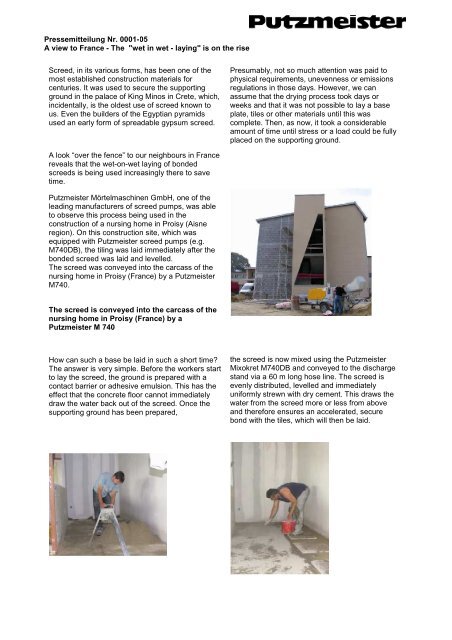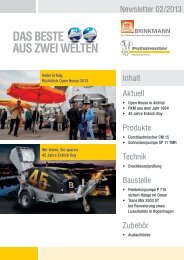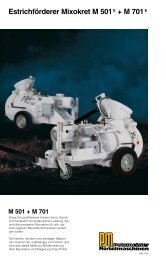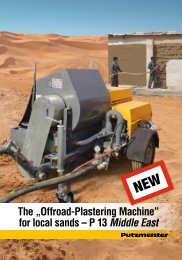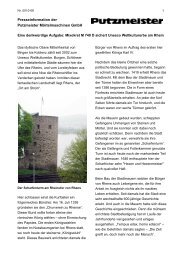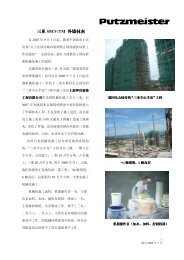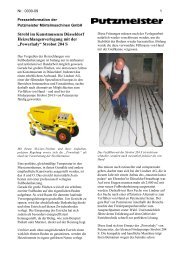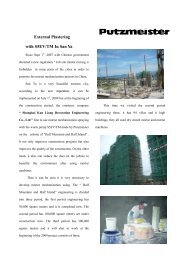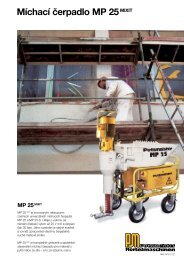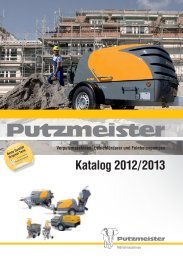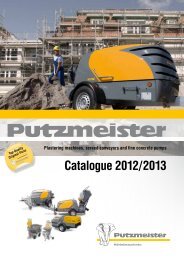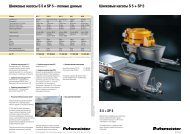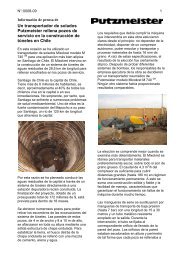English - Putzmeister Mörtelmaschinen
English - Putzmeister Mörtelmaschinen
English - Putzmeister Mörtelmaschinen
You also want an ePaper? Increase the reach of your titles
YUMPU automatically turns print PDFs into web optimized ePapers that Google loves.
Pressemitteilung Nr. 0001-05<br />
A view to France - The "wet in wet - laying" is on the rise<br />
Screed, in its various forms, has been one of the<br />
most established construction materials for<br />
centuries. It was used to secure the supporting<br />
ground in the palace of King Minos in Crete, which,<br />
incidentally, is the oldest use of screed known to<br />
us. Even the builders of the Egyptian pyramids<br />
used an early form of spreadable gypsum screed.<br />
A look “over the fence” to our neighbours in France<br />
reveals that the wet-on-wet laying of bonded<br />
screeds is being used increasingly there to save<br />
time.<br />
<strong>Putzmeister</strong> Mörtelmaschinen GmbH, one of the<br />
leading manufacturers of screed pumps, was able<br />
to observe this process being used in the<br />
construction of a nursing home in Proisy (Aisne<br />
region). On this construction site, which was<br />
equipped with <strong>Putzmeister</strong> screed pumps (e.g.<br />
M740DB), the tiling was laid immediately after the<br />
bonded screed was laid and levelled.<br />
The screed was conveyed into the carcass of the<br />
nursing home in Proisy (France) by a <strong>Putzmeister</strong><br />
M740.<br />
The screed is conveyed into the carcass of the<br />
nursing home in Proisy (France) by a<br />
<strong>Putzmeister</strong> M 740<br />
How can such a base be laid in such a short time?<br />
The answer is very simple. Before the workers start<br />
to lay the screed, the ground is prepared with a<br />
contact barrier or adhesive emulsion. This has the<br />
effect that the concrete floor cannot immediately<br />
draw the water back out of the screed. Once the<br />
supporting ground has been prepared,<br />
Presumably, not so much attention was paid to<br />
physical requirements, unevenness or emissions<br />
regulations in those days. However, we can<br />
assume that the drying process took days or<br />
weeks and that it was not possible to lay a base<br />
plate, tiles or other materials until this was<br />
complete. Then, as now, it took a considerable<br />
amount of time until stress or a load could be fully<br />
placed on the supporting ground.<br />
the screed is now mixed using the <strong>Putzmeister</strong><br />
Mixokret M740DB and conveyed to the discharge<br />
stand via a 60 m long hose line. The screed is<br />
evenly distributed, levelled and immediately<br />
uniformly strewn with dry cement. This draws the<br />
water from the screed more or less from above<br />
and therefore ensures an accelerated, secure<br />
bond with the tiles, which will then be laid.
Once completed, there is a delay of only 24 hours<br />
before the floor can be walked on without causing<br />
damage.<br />
The tiles are laid immediately. The floor can be<br />
walked on again after only 24 hours. The only limit<br />
is that, because the heat is generated "from below",<br />
the system does not work with underfloor heating.<br />
Contact:<br />
<strong>Putzmeister</strong>Mörtelmaschinen GmbH<br />
Frank Kretzschmar<br />
Max-Eyth-Str. 10<br />
72631 Aichtal<br />
mm@pmw.de<br />
http://www.moertelmaschinen.de/<br />
The <strong>Putzmeister</strong> experts observed that 4 workers<br />
were able to use this process to complete a fully<br />
tiled floor of approximately 100 m2 in only one<br />
day. Considering that the usual drying time for<br />
screed can be up to 3 weeks, the wet-on-wet<br />
laying process represents an enormous saving in<br />
both time and money.<br />
2<br />
2


